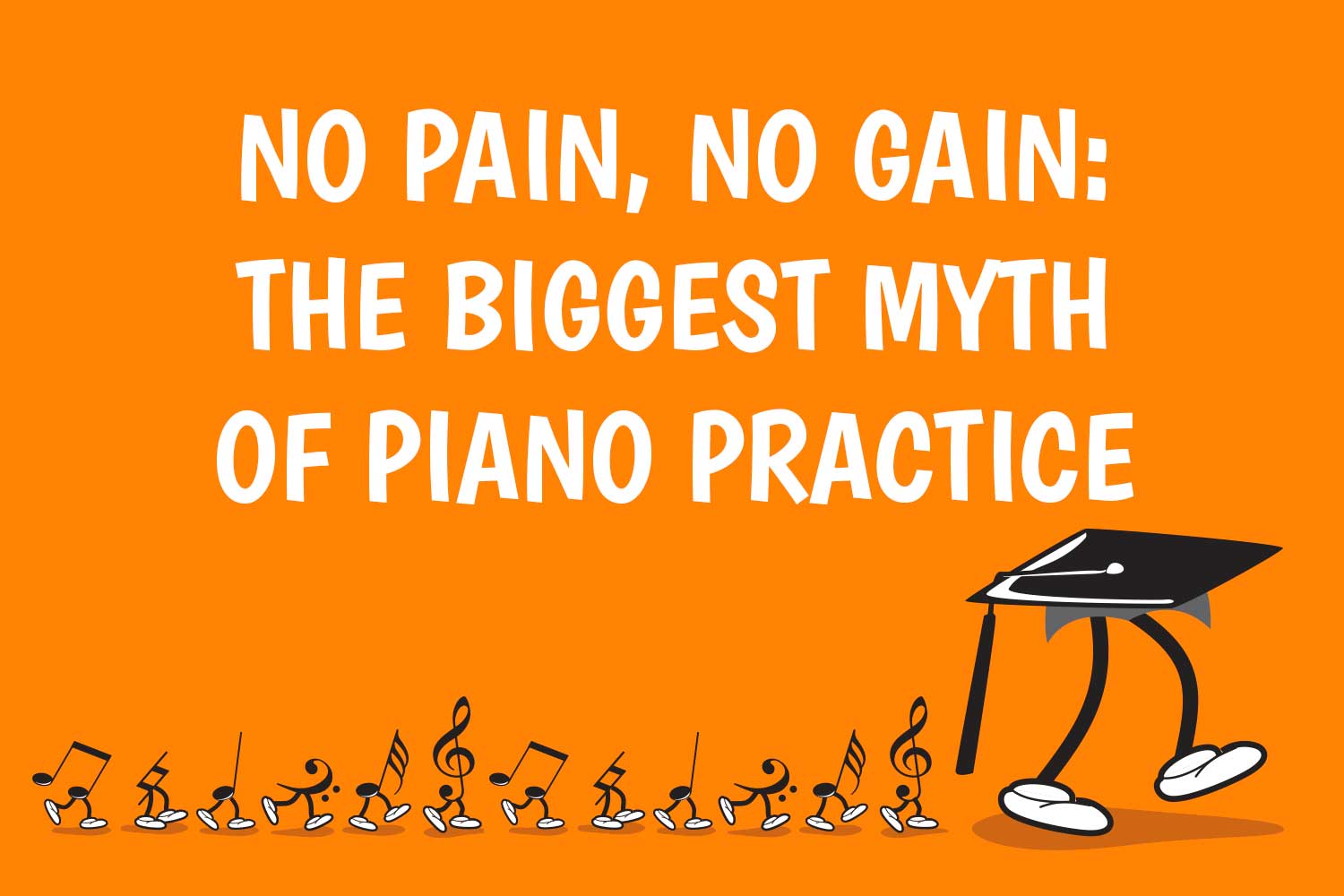No Pain, No Gain: The Biggest Myth of Piano Practice

On the weekend I attend one of the most enlightening workshops I have ever been to: Brenda Hunting and Anthony van den Broek presented a 2-day seminar on the Taubman approach.
Dorothy Taubman was the founder of the Taubman approach. She was not a scientist, doctor, physiotherapist or physician of any kind. She was a sensible pianist and piano teacher, who observed how the body actually worked while playing piano, and who eventually managed to help a great many pianists recover from their injuries. Here is the opening paragraph from her Wikipedia page:
“Dorothy Taubman (August 16, 1917 – April 3, 2013) was an American music teacher, lecturer and founder of the Taubman Institute of Piano, who developed the “Taubman Approach” to piano playing. Her approach to piano technique was based on an analysis of the motions needed for virtuosity and musical expression, but at first earned a reputation through its high rate of success in curing playing injuries. It provoked controversy by questioning the physiological soundness of some tenets of traditional piano teaching.”
I first remember hearing about the Taubman approach in 2015, when Therese Milanovic presented at the APPC. Some of the things she said blew me away. Things like “everyone is born with a beautiful natural piano playing hand” and she just held up a completely relaxed hand. She showed videos of pianists doing certain movements at the piano which looked good but which would lead to injury. She talked about her own injuries and how she recovered from them.
I read Therese’s thesis on this subject and it was eye-opening. Then I was lucky enough to have two lessons with her over the next six months and boy oh boy did I have to overhaul my own technique. Some of the things I had to change were very difficult to do; I found I couldn’t quite reconcile it all in my head straight away, because it conflicted so heavily with what I had been taught from a young age by my very conservative Russian piano teacher1, and even with how I had been teaching my own students.
| Things I was taught | Taubman approach |
| Hold arms out slightly | No – let the upper arm hang, otherwise it strains the shoulders (and my left shoulder is a disaster) |
| Curl fingers | No need, the hand in its relaxed state has naturally curved fingers. Especially important to leave thumb and pinky in their natural shape to play |
| Practice finger independence | Don’t do it! Places incredible strain on the muscles |
| Sit very straight (never much attention paid to seat height) | Sit high and forward – high enough so that forearm is parallel to floor without pushing elbows out, and leaning forward so that weight goes into legs and feet |
| Allow wrist to snap back for octaves and staccato playing | Use whole arm. It strains the wrist to pull it backwards |
| Turn/twist hand to get thumb/pinky on keys | This action causes tension. Move in and out to get to keys easily |
| Practice more to get used to stretches | Redistribute notes to avoid stretching |
| No pain, no gain | No pain IS your gain! |
“No pain, no gain” is something that we hear so often in the world of physical accomplishments. But it is a dangerous approach in piano and in fact my physiotherapist tells me it’s an absolute myth in any physical pursuit. Pain is your body’s way of telling you that something is wrong. It’s fine to practice hard and feel that your muscles are working – something that feels different for everybody2 – but if something is hurting you should stop. You are doing long-term damage to your body if you don’t.
We have to let go of the idea that unless we’re working to the point of pain we’re really not working hard enough. Dorothy Taubman had a wonderful quote on playing without pain that Brenda and Anthony kept coming back to over the weekend:
If playing the piano doesn’t feel delicious and euphoric, you’re doing something wrong.
I think that taking on new ideas about technique and letting go of what we’ve always ‘known’ can be really hard. It’s a bit like the climate change argument when it was first suggested – it took a long time and for many people to suggest it over and over again before it became acknowledged as valid.3
But ultimately, we don’t want to be injured, right? Let’s all embrace sensible, logical thinking that clearly puts pianistic health at the top of the priority list.4
For a fabulous article by Therese Milanovic on the Taubman approach, have a look at http://thepianoteacher.com.au/articles/the-taubman-approach-to-piano-technique/ and of course you can visit Brenda and Anthony’s site for more information: www.pianopedagogues.com
- I started learning from Mrs Skoblin when I was five years old, and stayed with her until I went to the Conservatorium High School. I was taught a traditional Russian piano technique. My passage work was fine but I could not play double octaves. In high school I had various teachers but never got over the double octave problem… I now know it’s because I was sitting at the incorrect height and angle, and my shoulders and neck are very tight even to this day. The method I was taught never addressed these fundamental issues.
- Dorothy Taubman believed that if the body is working properly there would be ‘a sensation of no sensation’. However that is very individual and most people are aware when muscles are moving/working compared to not.
- Apparently the same thing happened when people first suggested the Earth was round.
- Especially if that logical approach tells us to get rid of legato octaves – hooray! 😊

Great ideas!
Hi Samantha.
I attended the excellent Taubman seminar presented by Therese Milanovic and John Bloomfield in Brisbane in February. What an eye-opener! So much of what Dorothy Taubman espoused seems intuitive and common sense, and yet directly contradicts the way I and so many others were taught as students.
I found that I was intuitively incorporating many Taubman principles in my own teaching method without necessarily understanding the reasons for them. Now I do! While I didn’t agree with absolutely everything the presenters said, the seminar really inspired me to be more mindful of the way I approach the teaching of Piano technique to my students, and gave me permission to disregard many of the “traditional” things that I was taught, which I have long held on to.
Since consciously incorporating Taubman principles into my teaching method I have seen such an improvement in my students’ technique, even with my youngest beginners! I would be very interested to read more of your thoughts on the Taubman method as you explore it further.
Thanks Tara. I am certainly looking forward to exploring it further! Great to hear about the improvements in your own students’ technique.
Hi Samantha Thanks for this post. It’s great to see sensible, somatic information for musicians getting out there. I agree with your previous commenter who found the Taubman advice “intuitive and common sense” and yet also contradictory to how many of us are taught. I think when it comes to understanding how we are designed to move well, it is not very common nor intuitive. I have found a similar study, that of Body Mapping for musicians, to be like finally receiving the “handbook” of movement I should have received at birth, but never did! Now I can “translate” into my own movement the intent of an instruction from a teacher – usually with enough success that the teacher does not mind or even seem aware sometimes of just “how” I achieve it. I’ve found that with accessible, correct information I can move in harmony with my physical design rather than struggle against it to achieve my musical intent. And of course in playing and in teaching, it is key to improving so many outcomes in performance including preventing injury and increasing facility. Wouldn’t it be great if it were “common” knowledge amongst all musicians.
Agree completely Jane!
Pingback: Friday Finds #97 | Piano Pantry
After many, many years of teaching, as a studio teacher, as a classroom teacher and in state and private secondary schools, and now in my retirement years as a studio teacher again, I have tried to work with the student(s) I have in front of me, with their hands and bodies.There is so much music to choose from there is always something “to fit the student”.
Great to hear about Taubman’s work again in your News and information letter.
Thank you Samantha.
Thank you Frances. There is another blog about it, coming tonight!!!!
Pingback: Does Rote Teaching Work? – The Piano Teacher